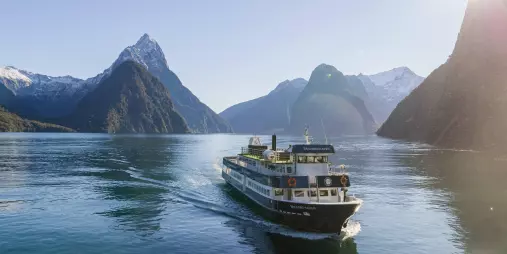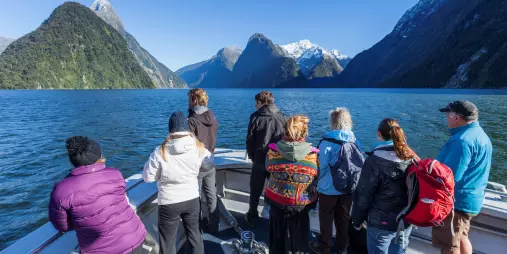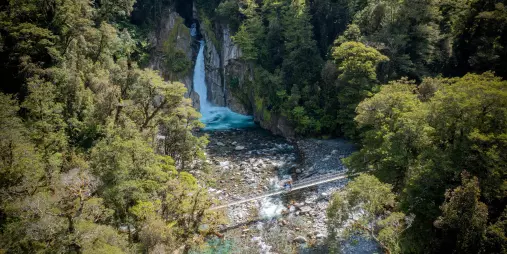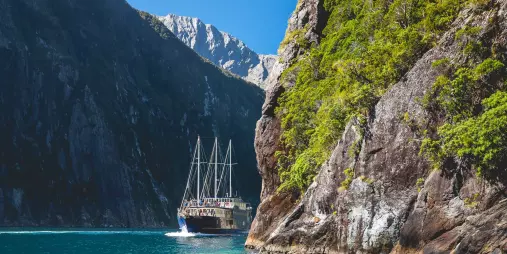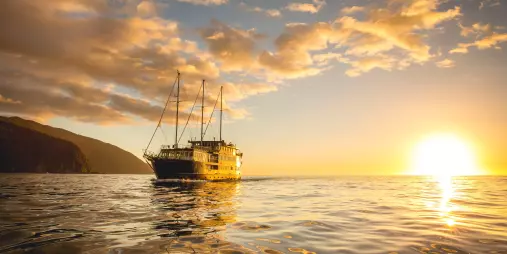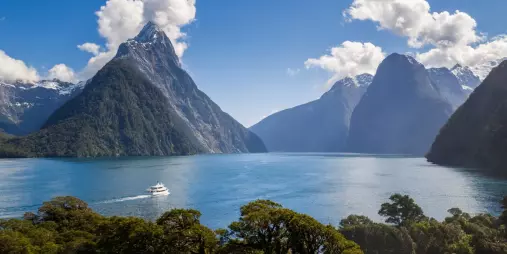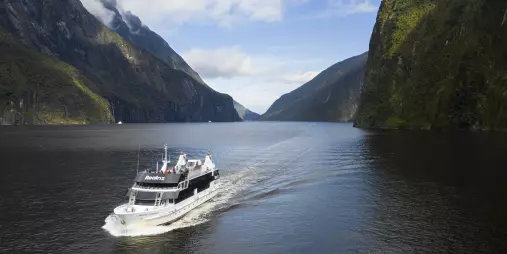Towering Cliffs, Rainforest Trails and Cascading Falls
Milford Sound New Zealand, located in Fiordland National Park, is one of the country’s most iconic natural landmarks. With vertical cliffs plunging into deep waters, dense rainforest clinging to the rock, and waterfalls tumbling from great heights, it’s no surprise this spectacular fiord is one of Aotearoa’s most photographed places.
The journey in along the Milford Road is part of the adventure, taking you through alpine landscapes, past glassy lakes, and through the famous Homer Tunnel. Whether arriving by car, coach or scenic flight, the sense of arrival at Milford Sound is unforgettable. At the fiord’s edge, visitors are greeted by dramatic vistas and the stillness of nature.
Cruises, Wildlife and Iconic Walks Nearby
A scenic boat cruise is the most popular way to experience Milford Sound, offering views of Stirling Falls, Bowen Falls, and towering peaks like Mitre Peak. Wildlife is often spotted on the water—seals, bottlenose dolphins, and occasionally Fiordland crested penguins. Some cruises even nudge close enough to the waterfalls for a refreshing spray.
While there are no long walks starting directly at Milford Sound, a water taxi to Sandfly Point gives access to a stunning day walk on the Milford Track, one of New Zealand’s Great Walks. For those travelling the Milford Road, nearby tracks like the Lake Marian Track, The Chasm Walk, and Key Summit are popular for their short but rewarding routes into the region’s lush, alpine environment.
Top Things to Do in Milford Sound New Zealand
Here are some of the best ways to enjoy Milford Sound and its surrounds:
- Take a boat cruise beneath towering cliffs and waterfalls
- Spot seals, dolphins, and penguins on a wildlife-focused tour
- Walk the Milford Track from Sandfly Point via water taxi
- Enjoy the short Foreshore Walk for views of Mitre Peak
- Visit The Chasm for dramatic waterfalls and rock formations
- Hike the Key Summit Track for alpine views (from Milford Road)
- Walk to Lake Marian through lush forest and past waterfalls
- Paddle a kayak for a peaceful on-the-water perspective
- Travel the scenic Milford Road with stops for photos and picnics
- Take a scenic flight from Te Anau or Queenstown for a bird’s-eye view
Hike One of New Zealand’s Great Walks
Milford Sound marks the end point of the world-renowned Milford Track — a 4-day trek through alpine valleys, waterfalls, and glacier-carved landscapes. Book early, as spots are limited and this is one of the most popular multi-day hikes in the country.
Milford Sound has a rich history, shaped by both Maori and European cultures. The Maori people have inhabited the region for over a thousand years, with evidence of their settlements and rock art still visible in the area. They called Milford Sound "Piopiotahi," meaning a single thrush, after a legend about a bird that flew to the area and never left. For the Maori, the region was a sacred place, where they gathered precious greenstone and hunted for food.
In the late 18th century, European explorers discovered Milford Sound and named it after Milford Haven in Wales. The first recorded European to visit the area was Captain John Grono, who named the sound "Milford Haven" in 1812. In the following years, sealers and whalers arrived in the area, leading to the depletion of the fur seal population.
In the late 19th century, Milford Sound became a popular tourist destination, with the establishment of the Milford Track, one of New Zealand's most famous hiking trails. In 1952, the Homer Tunnel was completed, making it easier for visitors to access Milford Sound by road.
Today, visitors to Milford Sound can still witness the rich history of both Maori and European cultures in the area, from the traditional rock art to the historic huts and tracks used by early explorers.
Getting to Milford Sound is an adventure in itself. Visitors can drive from Queenstown or Te Anau, with the road to Milford Sound offering spectacular views of the surrounding mountains and valleys. Alternatively, there are various tours available, including coach tours and boat tours, providing visitors with an informative and enjoyable way to experience Milford Sound. For those wanting a bird's eye view of the fiord, scenic flights and helicopter tours are also available.
While there is limited accommodation available in Milford Sound, the nearest main centre for accommodation is in Te Anau, a town located approximately 120 km from Milford Sound. Te Anau offers a range of accommodation options, including hotels, motels, lodges, and campsites, catering to different budgets and preferences. Staying in Te Anau is an excellent option for those wanting to explore Milford Sound and the wider Fiordland National Park.
Milford Sound is located in a temperate rainforest climate, which means it can experience high rainfall and cooler temperatures year-round. The average temperature during the summer months (December-February) is around 18°C (64°F), while in winter (June-August), the temperature drops to around 8°C (46°F). However, due to its location on the western side of the Southern Alps, Milford Sound can experience sudden changes in weather, including heavy rainfall, snow, and wind, even during the summer months.
Visitors are advised to bring warm clothing, waterproof gear, and sturdy footwear, especially if planning to go hiking or kayaking. It is always best to check the weather forecast before embarking on any activities. Despite the unpredictable weather, the beauty of Milford Sound is still breathtaking, and visitors can witness dramatic landscapes and waterfalls even in rainy conditions.



